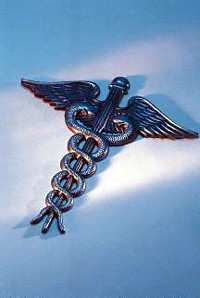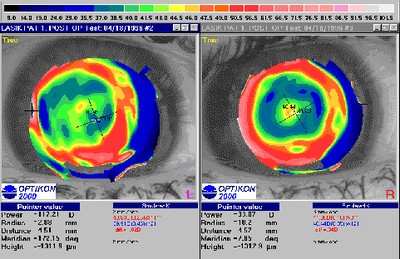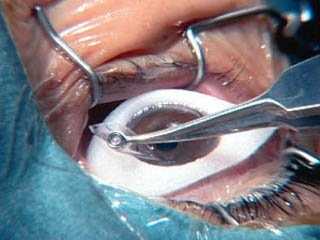Flight After LASIK Surgery
by Dr. Erwin Samuelson, AME and Jon Thornburgh, CFI
 This is the second in a series of
articles about aviation medicine. The first article discussed the
precautions a pilot should take after using Viagra. This article
will discuss the ramifications of laser eye surgery.
This is the second in a series of
articles about aviation medicine. The first article discussed the
precautions a pilot should take after using Viagra. This article
will discuss the ramifications of laser eye surgery.
It is estimated that half the American population requires
corrective lenses to enhance their vision. As evidenced by the
deluge of advertising for laser-corrected vision, such procedures
are becoming more and more popular. What is the FAA's response to
laser surgery?
The good news is that an airman who has successful laser surgery
can obtain or retain his medical certificate without a waiver.
However, the procedure is not without risk, and a pilot must be
aware of potential adverse outcomes.
The potential adverse effects of laser surgery include scarring
of the cornea, night-glare, sensitivity to bright light, and
inability to obtain the FAA required visual acuity. For both a
first-class and second-class medical certificate the pilot must
have distant visual acuity of 20/20 with or without corrective
lenses, and he must have near vision of at least 20/40. For a
third-class medical the pilot must have at least 20/40 vision,
distant or near, with or without correction.
There have been cases in which a pilot with poor eyesight was
able to correct his vision to 20/20 before laser surgery by using
glasses or contacts, but was unable to correct his vision to 20/20
after laser surgery. This, of course, would jeopardize his ability
to obtain a first or second-class medical certificate. (A
first-class medical is required for airline pilots, second-class
for other commercial pilots, and third-class for private
pilots.)
The surgical complications which can result in the inability to
obtain 20/20 vision include a detached corneal flap, epithelial
ingrowth in the corneal flap, perforation or hemorrhages of the
eye, and technical problems with the surgical instruments or the
surgeon's skill.
FAA-accepted surgical procedures for vision correction include
radial keratotomy, epikerato-phakia, PRK, and LASIK. Of these four
methods, LASIK (Laser Assisted in Situ Keratomileusis) is the most
popular. Using a precision instrument, the ophthalmologist creates
a thin flap from the front of the cornea. The corneal flap is
folded aside and a laser is used to reshape the portion of the
cornea underlying the flap. The corneal flap is then returned to
its original position.
A minority of patients choose PRK (Photorefractive Keratectomy)
over LASIK. PRK is a simpler procedure. The ophthalmologist
utilizes a laser beam that vaporizes the corneal tissue and reduces
the cornea's curvature, correcting for myopia (nearsightedness.)
Although less complicated, PRK is more likely to result in corneal
scarring. However, LASIK has a greater surgical risk than PRK,
because the inner corneal tissue is exposed when the corneal flap
is folded back. It is generally considered that an ophthalmologist
is required to have more skill and training to perform LASIK than
PRK.
What should a pilot do if he is considering laser eye
surgery?
One option is to ignore the FAA medical implications and just
have the procedure done. The pilot must voluntarily ground himself
until his eyes have stabilized. This can require a month, or as
long as six months. After the eyes have stabilized, the
ophthalmologist will perform a follow-up examination. He will then
submit a written report to the FAA Aeromedical Certification
Division in Oklahoma City. The report should contain a statement of
the type of procedure performed, a detailing of any complications,
an evaluation of the pilot's new visual acuity, and a statement
that his vision has stabilized. With his statement the
ophthalmologist should also submit FAA Form 8500-7, "Report of Eye
Evaluation.
The pilot may obtain Form 8500-7 from the FAA or from his AME.
The FAA Aeromedical Certification Division address is 6500 S.
MacArthur, Oklahoma City, Oklahoma 73169. The telephone number is
405-954-4821.
There is some ambiguity as to whether the pilot can begin flying
again without a notification of approval from Oklahoma City. Dr.
Warren Silberman manages the Civil Aeromedical Institute's
Aeromedical Certification Division. According to his article "RK
and Laser Visual Acuity Procedures," published in the Fall 1998
issue of the Federal Air Surgeon's Medical Bulletin the pilot may
resume flying unless notified otherwise by the FAA.
However, a pilot may inadvertently begin flying without knowing
that his vision does not meet the FAA's standards. For example,
after the LASIK surgery his distant vision may be 20/20. His
ophthalmologist may declare that the pilot's near vision is 20/40,
which meets the FAA's standard for near vision. "Near vision" is
defined as vision at 16 inches.
However, in order for a pilot after the age of 50 to qualify for
a first-class medical certificate the FAA requires that a pilot's
"intermediate vision" also be 20/40 or better. "Intermediate
vision" is determined by a visual acuity test at 32 inches. If a
pilot begins flying with intermediate vision less than 20/40 he
would be violating the parameters of his first-class physical, and
thus flying illegally. Doing so could result in FAA disciplinary
action and even invalidate his aviation insurance if he has an
accident.
A person who is nearsighted usually will not require reading
glasses as he ages. However, if a person undergoes laser surgery
and obtains 20/20 distant vision, he will need reading glasses or
bifocals as he ages. Some nearsighted patients have opted for the
"best of both worlds" by having laser surgery on only one eye.
After surgery, one eye will see normally at a distance and the
other will be able to see at close range. Vision of this type is
called "monocular vision." A famous person with monocular vision is
talk show advisor Dr. Laura Schlessinger, who once remarked on her
show that she had difficulty threading a needle, since only one eye
focused at arm's length.

May a pilot fly with monocular vision? The answer is "no,"
unless the FAA grants a waiver. In fact, question 17a on FAA Form
8500-8 ("Application for Airman Medical Certificate") specifically
asks, "Do you ever use near vision contact lenses while
flying?"
Having laser surgery, which results in monocular vision, is
another example of a way that a pilot may unknowingly get into
trouble if he begins flying after surgery without voluntarily
consulting his AME.
A pilot is not required to consult his AME prior to undergoing
LASIK surgery. Nor must he see his AME immediately after surgery.
It's possible that the first time that the AME becomes aware of the
LASIK surgery is when the pilot undergoes his next regularly
scheduled FAA physical exam. At that time the AME may discover that
the pilot had been flying for several months with a disqualifying
medical condition. That's when the pilot faces trouble.
A wiser approach to contemplated eye surgery would be to notify
the AME in advance and consult with him. Also, if a pilot wants to
be absolutely certain that his vision meets all FAA requirements
after surgery, he can voluntarily submit to a new FAA physical
exam, even though his present medical certificate has not expired.
After the pilot passes his new physical exam he can be confident
that he is flying legally.
Another alternative is to engage the services of Pilot Medical
Solution, Inc., which specializes in offering medical information
and assistance for pilots. A pilot may contact Pilot Medical
Solutions for advice on eye surgery before undertaking the
procedure. In fact, Pilot Medical Solution specializes in Proactive
Aeromedical Management, which offers pre-certification screening
for any medical procedure. There is no charge for this initial
consultation.
Pilot Medical Solutions will work with the pilot's
ophthalmologist to ensure that he is aware of the FAA's reporting
requirements and format. If the pilot has not selected an
ophthalmologist, Pilot Medical Solutions has a database of
recommended ophthalmologists who are familiar with the FAA's
protocol. Pilot Medical Solutions will include the pilot's AME in
the communication process.
After surgery the ophthalmologist can submit his follow-up
report and Form 8500-7 to Pilot Medical Solutions instead of the
FAA Aeromedical Certification Division. Pilot Medical Solutions
will review the paperwork for substance and format, and request
modifications or clarifications from the ophthalmologist, if
necessary. When the paperwork is satisfactory, Pilot Medical
Solutions will hand-carry the documents to the FAA Aeromedical
Certification Division, which is located nearby. By utilizing the
services of Pilot Medical Solutions, a pilot may be assured that
everyone observes the FAA protocol and that he is legal to fly as
soon as possible.
In the discussion above about monocular vision it was noted that
a pilot may fly with monocular vision, if he/she obtains a waiver
from the FAA. At the present time there are 185 pilots that hold a
monocular vision waiver for a first class medical, 348 for second
class, and 1,975 for third class. These waivers are specifically
for pilots who are flying with acceptable vision in only one eye,
such as Wiley Post, who was the first to do so.
Obtaining a medical waiver is often difficult and usually
requires special expertise. Waivers may be obtained either by
documented Operational Experience (OE) or a Medical Flight Test
(MFT.)
Pilot Medical Solutions has assisted many pilots with these
waivers.

The address for Pilot Medical Solutions, Inc. is Hangar 14,
Wiley Post Airport, 5901 Philip J. Rhoades, Suite 227, Bethany,
Oklahoma, 73008. The telephone numbers are 800-699-4457 or
405-787-0303. FAA Form 8500-7 and other medical forms may be
downloaded from the Pilot Medical Solutions web site.
Ultralight, glider, and balloon pilots are not required to have
a medical certificate, and according to the FAA, neither will a
pilot who flies in accordance with the proposed Sport pilot
certificate. However, these pilots are cautioned that safety of
flight requires that they exercise care after laser surgery. Even
though these pilots do not need an examination by an AME, they
should consult their ophthalmologist before flying.
The FAA requires that pilots who have a medical certificate must
voluntarily ground themselves when they are aware of a medical
condition that would preclude safe flight. In other words, a pilot
cannot exercise the privileges of his medical certificate when he
knows that he is suffering from a temporary disability.
Glider, balloon, and Sport pilots should also voluntarily ground
themselves for an adverse medical condition. Though not required by
FAA regulations, even ultralight pilots should be aware of the same
adverse medical conditions that would ground medically certificated
pilots. Good health is a prerequisite for safe flight, whether a
pilot is legally required to hold a medical certificate or
not.
About The Authors:
Dr. Erwin Samuelson has been a Senior Aviation Medical Examiner
for 25 years, and is a Diplomat American Board of Family Practice.
He is the author of a pamphlet entitled "Aviation Medicine--A
Survival Guide." Dr. Samuelson is also a contributor to Pilot
Medical Solutions, which specializes in assisting pilots in
regaining their medical certificates after initial refusal by the
FAA. His e-mail address is DrErwin@aol.com.
Jon Thornburgh is an ultralight and FAA flight instructor and
the author of numerous aviation articles. Jon's e-mail address is
JonThornburgh@pocketmail.com.
Special thanks to David Hale, Executive Director of Pilot
Medical Solutions, for supplying reference material and
proofreading the manuscript.
 ANN's Daily Aero-Linx (04.30.25)
ANN's Daily Aero-Linx (04.30.25) ANN FAQ: Turn On Post Notifications
ANN FAQ: Turn On Post Notifications Classic Aero-TV: Agile Aeros Jeff Greason--Disruptive Aerospace Innovations
Classic Aero-TV: Agile Aeros Jeff Greason--Disruptive Aerospace Innovations Aero-News: Quote of the Day (04.30.25)
Aero-News: Quote of the Day (04.30.25) ANN's Daily Aero-Term (04.30.25): Expedite
ANN's Daily Aero-Term (04.30.25): Expedite





